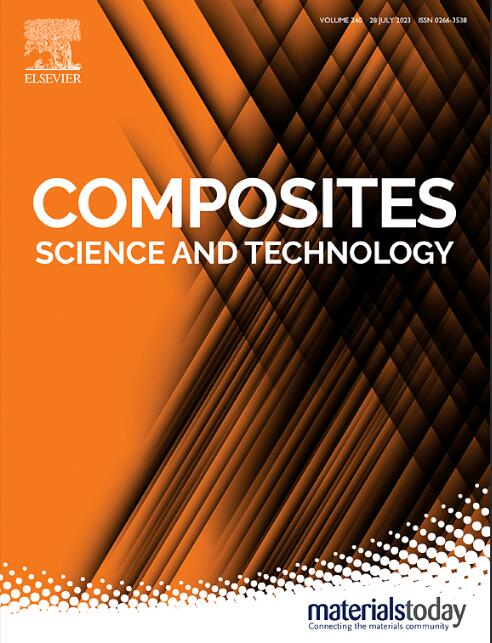仿生、机械强韧的丝素/芳纶纳米纤维复合材料作为压阻传感器,具有优异的灵敏度和抗液体干扰性能
IF 8.3
1区 材料科学
Q1 MATERIALS SCIENCE, COMPOSITES
引用次数: 0
摘要
具有可持续性、舒适性、先进性和多功能性的可穿戴传感器设备越来越受到人们的青睐。基于丝素蛋白(SF)的传感器器件因其生物相容性、生物可降解性和低制造成本而具有广阔的应用前景。然而,现有的基于sf的传感器器件难以实现优异的机械性能、高导电性和抗液体干扰性能。芳纶纳米纤维具有高纵横比和优异的力学性能,是制备高性能复合材料的常用硬段材料。然而,通过去质子化制备的ANFs分散体对水的敏感性高,制备时间长(一周),限制了其实际应用。本文以天然软组织优异的力学性能为灵感,将丝素/芳纶纳米纤维与水分散的丝素/芳纶纳米纤维进行仿生杂交制备丝素/芳纶纳米纤维复合材料。SF/ANFs复合材料的力学性能高于其他先前报道的SF基复合材料,这些复合材料进一步用金纳米粒子(Au NPs)和氟碳(FC)树脂进行改性,以促进导电性和疏水性的结合。结果表明,柔性导电SF/ANFs/Au@FC复合材料作为压阻式传感器具有优异的灵敏度、较宽的压力检测间隔和抗液体干扰性能。本工作提出了一种简单、省时的制备水分散ANFs的方法,为与水溶性材料杂交开辟了新的可能性。复合材料和传感器提供的机械洞察力和可制造性可能为材料设计和技术创新提供进一步的机会。本文章由计算机程序翻译,如有差异,请以英文原文为准。

Biomimetic, mechanically strong silk fibroin/aramid nanofiber composite as piezoresistive sensor with excellent sensitivity and anti-liquid-interfering properties
Wearable sensor devices with sustainability, comfortability, advancement and versatility are increasingly in demand. Silk fibroin (SF)-based sensor devices are promising candidates due to their biocompatibility, biodegradability and low manufacturing cost. However, the existing SF-based sensor devices are difficult to achieve the excellent mechanical properties, high conductivity and anti-liquid-interfering properties. Aramid nanofibers (ANFs) with a high aspect ratio and excellent mechanical properties are usually served as the stiff segments to fabricate high-performance composites. Nevertheless, ANFs dispersion prepared via deprotonation exhibit high sensitivity to water, along with long preparation time (one week), limiting its practical applicability. Herein, inspired by the extraordinary mechanical properties of natural soft tissues, the silk fibroin/aramid nanofibers (SF/ANFs) composites were fabricated by the biomimetic hybridization between the SF and water-dispersible ANFs. The SF/ANFs composites showed higher mechanical properties than that of other previously reported SF-based composites, which were further modified with gold nanoparticles (Au NPs) and fluorocarbon (FC) resin to facilitate the integration of conductivity and hydrophobicity. As a result, the flexible and conductive SF/ANFs/Au@FC composite as piezoresistive sensor exhibited excellent sensitivity, broad pressure detection interval and anti-liquid interfering properties. This work presented a simple and time-saving procedure to prepare the water-dispersible ANFs, opening up new possibilities for hybridization with water-soluble materials. The mechanistic insights and manufacturability provided by the composite and sensor might present further opportunities for materials design and technological innovation.
求助全文
通过发布文献求助,成功后即可免费获取论文全文。
去求助
来源期刊

Composites Science and Technology
工程技术-材料科学:复合
CiteScore
16.20
自引率
9.90%
发文量
611
审稿时长
33 days
期刊介绍:
Composites Science and Technology publishes refereed original articles on the fundamental and applied science of engineering composites. The focus of this journal is on polymeric matrix composites with reinforcements/fillers ranging from nano- to macro-scale. CSTE encourages manuscripts reporting unique, innovative contributions to the physics, chemistry, materials science and applied mechanics aspects of advanced composites.
Besides traditional fiber reinforced composites, novel composites with significant potential for engineering applications are encouraged.
 求助内容:
求助内容: 应助结果提醒方式:
应助结果提醒方式:


